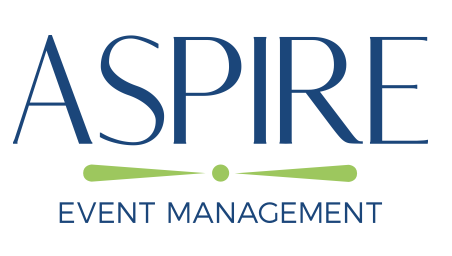The Psychology of Color
Color has a profound effect on our emotions and behaviors. Understanding the psychology of color can help you choose the right palette to convey the desired mood or atmosphere for your event. It is also important to consider how much of a color to use. For example, yellow evokes confidence and joy, however if you use too much of it, it can cause anxiety and overstimulate attendees. By strategically selecting colors, you can set the tone for your event and leave a lasting impression on your guests.

Balancing Contrast and Harmony
Finding the right balance between contrasting and harmonious colors is crucial in event design. Too much contrast can be overwhelming, while too much harmony may lead to a lack of visual interest. Understanding color theory, including complementary, analogous, and triadic color schemes, can help you strike the right balance and create a visually appealing environment.
ASPIRE Insight: If you are struggling with creating the right contrast and harmony, we recommend starting with your darkest brand color- set this as your base/main color. Then select your brightest brand color and have this be your accent color. See in the picture below how we took our client’s darkest brand color- navy- and used it as the linen color for the base. We then utilized their brightest brand color- green- and used it as an accent color with the napkins. Following this rule, we created an analogous color scheme of blue and green for their event.

Branding and Consistency
Incorporating your brand colors into your event design is a powerful way to reinforce your brand identity. Consistency in color across all event materials, from invitations to signage and decor, helps create a cohesive and memorable experience for attendees. It also reinforces brand recognition, making your event instantly identifiable with your organization or company. If you are tired of your brand colors or feel the event style is getting boring, consider using a different hue of your primary color. You can also pull from your brand’s accent colors and make one of them the main color for your event. If you incorporate a known color of your brand or a symbol or pattern, you can change the pallet to surprise and intrigue your attendees.
Creating Visual Hierarchy
Color can be used to guide attendees’ attention and highlight important elements. For example, using a bold, contrasting color for key information such as event schedules, speaker names, or important announcements can ensure they stand out. This visual hierarchy helps attendees navigate the event smoothly and ensures they don’t miss crucial details.
ASPIRE in Action: At one of our conferences, we provided attendees with 1 of 4 different colored lanyards. The attendees’ lanyard color determined their track for breakout sessions. This not only created excitement for attendees, but it also established an equal number of attendees in each breakout session.
Considering Cultural Significance
Colors hold different meanings and significance in various cultures. It’s essential to research the cultural implications of colors, especially if your event has an international audience or if you’re working with a diverse group of attendees. Being aware of cultural associations with colors will help you avoid unintentional misunderstandings and ensure your event is inclusive and respectful.

Practical Considerations: Lighting and Venue
The lighting conditions and venue space play a significant role in how colors are perceived. Natural light, artificial lighting, and the layout of the venue can all impact the way colors appear. It is important to consider these factors when selecting your color palette to ensure that the chosen colors translate well in the actual event space.
ASPIRE Insight: A lot of event spaces have colorful, patterned carpets, which can distract from your event branding and colors. Possible solutions may include narrowing down your color palette to include specific brand colors that appear in the existing carpet, renting temporary event flooring- wood, high gloss, or carpet overlay; or simply using dynamic lighting to distract from the carpet.
Overall, color is an especially important and powerful tool in event design. It guides the attendees’ emotions and experiences throughout the event- telling them if the space is playful or professional, elegant or causal, highly interactive or relaxed, and so much more. Utilizing color does not have to be intimidating. ASPIRE can help you get creative and have fun utilizing color to transform your event into an unforgettable experience.
Want even more help and insight into using color at your next event? Contact our team today to learn more about ASPIRE’s event design services.
